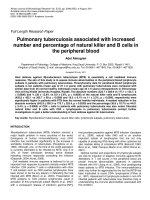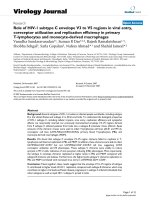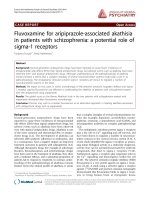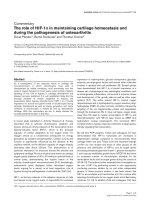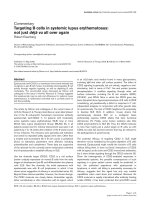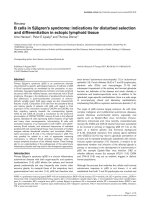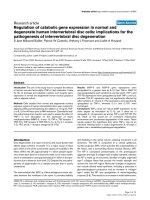The role of b cells in the pathogenesis of atherosclerosis 1
Bạn đang xem bản rút gọn của tài liệu. Xem và tải ngay bản đầy đủ của tài liệu tại đây (2.35 MB, 97 trang )
!
i!
THE ROLE OF B CELLS IN THE PATHOGENESIS OF
ATHEROSCLEROSIS
KHOO HAN BOON LAWRENCE
(B.Sc (HONS.), NUS)
A THESIS SUBMITTED
FOR THE DEGREE OF DOCTOR OF PHILOSOPHY
DEPARTMENT OF MICROBIOLOGY
YONG LOO LIN SCHOOL OF MEDICINE
NATIONAL UNIVERSITY OF SINGAPORE
2013
!
ii!
DECLARATION
I hereby declare that the thesis is my original work and it has been written by
me in its entirety. I have duly acknowledged all the sources of information
which have been used in the thesis.
This thesis has also not been submitted for any degree in any university
previously.
Khoo Han Boon Lawrence
July 2013
!
iii!
Acknowledgements
First and foremost, this thesis is not possible without the generosity
shown by my supervisor, Dr. Veronique Angeli, who allowed me the freedom
to define and pursue the scope of this project. It was always rewarding and
fruitful whenever we have a discussion no matter how short or long (or very
long ones!) they could be. Her guidance and quiet support are a pillar of
strength and encouragement to rely on during the years. Her financial support,
both in overseas conferences and continuation of my candidature, has been a
tremendous help in pursuit of my research interest. For all these, I’ll like to
express my deepest gratitude. Thank you.
Next, I’ll like to thank my labmates who accompanied me along the
journey of my graduate studies. Thank you Fiona, for being a steadfast partner
during mice harvest and your help in dissecting the aortas. Thank you Jocelyn,
for the helpful discussions. To Angeline, Kim, Kar Wai, Serena, Sheau Ying
and Michael, thank you for the help and support in lab matters.
I’ll also like to thank many friends I made in the Immunology
Programme as well as in Singapore Immunology Network (SIgN) for the help
they rendered in however big or small and not to mention the light-hearted
moments! I’ll like to specially thank Dr. Paul Hutchinson, Guo Hui and Fei
Chuin for assistance in cell sorting experiments. Also, special thanks to Dr.
Florent Ginhoux and Peter See for providing the CD11c-GFP-DTR mice.
Last but not least, I’ll like to dedicate this thesis to my family and
express my deepest gratitude to my parents for their unwavering support in the
pursuit of my graduate studies.
!
iv!
Table of Contents
DECLARATION ………………………………………………… ii
ACKNOWLEDGEMENTS …………………………………… … iii
TABLE OF CONTENTS ………………………………………… iv
ABSTRACT ………………………………… xv
LIST OF TABLES xvii
LIST OF FIGURES xvii
LIST OF ABBREVIATIONS xxi
Chapter 1: Introduction
1.1 Main Immunological Features in Atherosclerosis 2
1.2 Experimental Mice Models of Atherosclerosis 5
1.3 B cell subset populations 7
1.3.1 B1 cells 7
1.3.2 B2 cells 10
1.3.2.1 Follicular B cells 10
1.3.2.2 Marginal Zone B cells 11
1.4 Humoral Immunity in Atherosclerosis 12
1.4.1 Localization of B cells in Atherosclerosis 12
1.4.2 Association of oxLDL-specific antibodies with
Atherosclerosis 14
1.4.3 Cloning of oxLDL-specific B cells 18
!
v!
1.4.4 B1 cell origin of oxLDL-specific monoclonal antibodies 19
1.4.5 Function of oxLDL-specific Antibodies 21
1.4.6 The role of B cells in Atherosclerosis: Pathogenic or
protective? 22
1.5 Humoral B cell responses 24
1.5.1 Critical factors in differential antibody producing pathways 24
1.5.1.1 Antigen-BCR Interactions 25
1.5.1.2 Epstein-Barr virus-induced molecule 2 (EBI2) 25
1.5.1.3 B cell responses master regulators 27
1.5.2 Extrafollicular responses 29
1.5.3 Germinal centres 34
1.5.4 Long-lived plasma cells 40
1.5.4.1 Migratory competency 44
1.5.4.2 Survival factors for plasma cells 47
1.5.4.3 Role of CD28 on longevity of plasma cells 50
1.5.4.4 Cellular sources of survival factors 51
1.6 Objectives 53
!
vi!
Chapter 2: Materials & Methods
2.1 Mice 55
2.1.1 Generation of mice chimera 55
2.1.2 Splenectomy 55
2.2 Immunization 56
2.3 Adoptive transfer 56
2.4 Ezetimibe treatment 56
2.5 BrdU and EdU administration 56
2.6 Plasma collection 57
2.7 Cell isolation from tissues 57
2.7.1 Isolation of cells from spleen and lymph nodes 57
2.7.2 Isolation of cells from bone marrow 58
2.7.3 Isolation of cells from peritoneal 58
2.8 Viability cell count 58
2.9 Flow cytometry 59
2.9.1 Cell surface staining 59
2.9.2 Intracellular staining 59
2.9.3 EdU staining for flow cytometry 60
2.9.4 5-bromodeoxyuridine (BrdU) staining 60
!
vii!
2.9.5 Flow cytometry acquisition and analysis 61
2.9.6 Cell sorting 61
2.10 Enzyme-Linked Immunosorbent Assay (ELISA) 62
2.10.1 Quantification of total IgM and IgG 62
2.10.2 Measurement of anti-LDL and anti-oxLDL autoantibodies 62
2.10.3 Quantification of PC-specific antibodies 63
2.10.4 Measurement of OD and analysis 63
2.11 Enzyme-Linked Immunosorbent Spot (ELISpot) 64
2.11.1 Image acquisition and analysis 64
2.12 Cell culture 65
2.13 Immunofluorescence 66
2.13.1 Preparation of tissues for immunofluorescence staining 66
2.13.2 Immunofluorescence staining 66
2.13.2.1 Immunofluorescence staining with primary and/or
secondary antibodies 66
2.13.2.2 Immunofluorescence staining with biotin-conjugated
antibodies 67
2.13.2.3 Immunofluorescence staining with anti-mouse CD138
antibodies 67
!
viii!
2.13.2.4 Revealing EdU
+
cells in tissue sections 68
2.13.3 Image acquisition and analysis 68
2.14 Quantification of germinal center and extrafollicular responses 68
2.15 Quantification of lesion size 69
2.16 Oil Red-O staining 69
2.16.1 Image acquisition 69
2.17 Real-time Polymerase Chain Reaction (real-time PCR) 70
2.17.1 RNA Extraction 70
2.17.2 Reverse transcription 70
2.17.3 Primer Design 71
2.17.4 Real-time PCR Protocol 71
2.18 Mass spectroscopy analysis of samples 72
2.18.1 Extraction of sterols from tissue samples 72
2.18.2 High Performance Liquid Chromatography – Mass
Spectrometry (HPLC-MS) method 72
2.19 Statistical Analysis 73
!
ix!
Chapter 3: Results
3.1 Characterization of antibody responses in plasma of atherosclerotic
experimental mice model, apoE
-/-
75
3.1.1 Elevated total IgM and oxLDL-specific IgM autoantibodies in
circulation with disease progression 75
3.1.2 No increase in PC-specific IgM autoantibodies in circulation . 76
3.1.3 Summary 81
3.2 Comparative evaluation of humoral responses in secondary lymphoid
organs – spleen and lymph nodes 82
3.2.1 Hypertrophy of lymph nodes, but not the spleen, in apoE
-/-
mice 82
3.2.2 Evaluation of antibody-producing plasma cells in secondary
lymphoid organs in apoE
-/-
mice 84
3.2.3 Evaluation of antibody producing pathways in secondary
lymphoid organs in apoE
-/-
mice 86
3.2.3.1 Germinal center reactions increase significantly in the
lymph nodes 86
3.2.3.2 Robust extrafollicular responses were observed in the
spleen of apoE
-/-
mice 91
3.2.4 Evaluation of antibody responses in secondary lymphoid organs
in apoE
-/-
mice 96
!
x!
3.2.5 Summary 100
3.3 Evaluation of antibody producing pathways in contributing total IgM
and oxLDL-specific IgM autoantibodies in spleen of apoE
-/-
mice 101
3.3.1 Splenic GCs from apoE
-/-
mice were not defective in producing
isotype-switched plasma cells 101
3.3.2 Plasmablasts in extrafollicular responses were IgM
+
104
3.3.3 Summary 108
3.4 Evaluation of molecular cues to direct extrafollicular responses in the
spleen of apoE
-/-
mice 109
3.4.1 Increased ch25h mRNA expression in the spleen of apoE
-/-
mice 109
3.4.2 Increased oxysterol in the spleen of apoE
-/-
mice 110
3.4.3 Summary 112
3.5 Antibody production of B1a cells in apoE
-/-
mice 113
3.5.1 B1a cells were not expanded in PEC of apoE
-/-
mice 113
3.5.2 Increased splenic B1a cells differentiation into IgM
+
plasmablasts 114
3.5.3 Summary 118
3.6 Evaluation of the impact of splenic CD138
+
ASCs on
atherosclerosis 119
!
xi!
3.6.1 Adoptive transfer of splenic CD138
+
ASCs into apoE
-/-
mice 119
3.6.2 Summary 123
3.7 Evaluation of ASCs in bone marrow of apoE
-/-
mice 124
3.7.1 Accumulation of IgM
+
long-lived plasma cells in the bone
marrow of apoE
-/-
mice 124
3.7.2 Summary 127
3.8 Evaluation of IgM
+
plasmablasts migration from the spleen to bone
marrow of apoE
-/-
mice 128
3.8.1 Bone marrow was generating humoral responses in the absence
of spleen in apoE
-/-
mice 128
3.8.2 Evaluation of bone marrow compartment after disruption of
humoral responses in the spleen 131
3.8.2.1 Suitability of ldlr
-/-
mice 131
3.8.2.2 Detection of EdU
+
new migrant IgM
+
plasma cells in bone
marrow 135
3.8.2.3 Evaluation of bone marrow compartment after DT
administration in chimeric mice 137
3.8.3 Summary 141
!
xii!
3.9 Evaluation of humoral responses being associated with
hypercholesterolemic setting in the apoE
-/-
mice 142
3.9.1 Evaluation of total IgM and oxLDL-specific IgM autoantibodies
in apoE
-/-
mice after ezetimibe treatment 143
3.9.2 Evaluation of splenic extrafollicular responses in apoE
-/-
mice
after ezetimibe treatment 145
3.9.3 Evaluation of IgM
+
antibody secreting cells in the spleen of
apoE
-/-
mice after ezetimibe treatment 147
3.9.4 Evaluation of GC in the lymph node compartment of apoE
-/-
mice 150
3.9.5 Evaluation of IgM
+
antibody secreting cells in the bone marrow
of apoE
-/-
mice after ezetimibe treatment 155
3.9.6 Summary 157
!
xiii!
Chapter 4: Discussion
4.1 Summary of findings 159
4.2 Functional importance of IgM antibodies 161
4.3 Splenic humoral responses 163
4.4 Molecular cues in extrafollicular responses 164
4.5 Presence of oxLDL in plasma 166
4.6 Existence of tolerance mechanism? 168
4.7 Role of B cell subpopulations 169
4.8 Absence of oxLDL-specific humoral response in lymph node 171
4.9 Immune response or homeostatic response against oxidative modified
lipids? 173
4.10 IgM
+
plasma cells in bone marrow 175
4.11 In situ generation of oxLDL-specific IgM plasma cells in bone
marrow? 176
4.12 Trafficking to bone marrow 177
4.13 Selection into bone marrow compartment 179
4.15 Implication of study 180
4.14 Limitations of study 182
!
xiv!
4.15 Future Work 183
4.15.1 Measurement of oxLDL in plasma 183
4.15.2 Importance of 7α, 25-OHC in mediating extrafollicular
responses 183
4.15.3 Participation of B1a cells in splenic extrafollicular
responses 184
4.15.4 Survival factors present in bone marrow in
atherosclerosis 186
4.16 Conclusion 188
References 189
Appendix 1. Buffers and Media 227
Appendix 2. List of antibodies used in flow cytometry 228
Appendix 3. List of antibodies used in immunofluorescence 229
Appendix 4. List of primers used 230
!
xv!
ABSTRACT
Atherosclerosis is a chronic inflammatory disease of the arteries. The
presence of modified self-lipid specific autoantibodies such as anti-oxidized
low-density lipoprotein (oxLDL) has been reported in clinical and
experimental atherosclerosis, implying the involvement of humoral B cell
responses. However, the understanding of the mechanism(s) by which B cells
differentiate into plasma cells in response to atherosclerosis and how these
autoantibodies are sustained have been poorly explored. Therefore, we aim to
address the following questions in atherosclerotic apoE
-/-
mouse model: (i) in
which secondary lymphoid organs the antibody response against oxLDL takes
place; (ii) which antibody producing pathway(s) – extrafollicular responses or
germinal centre (GC) reaction is involved in the development of this B cell
response; (iii) whether the bone marrow compartment may sustain this
antibody response.
In the present study, our ELISA analysis indicated elevated total and
oxLDL-specific IgM autoantibodies in the circulation of atherosclerotic apoE
-
/-
mice. These observations corresponded to an increase in the population of
B220
-
CD138
+
plasma cells detected in the spleen and lymph nodes, suggesting
that differentiation into plasma cells occurs at these sites. However, the
dominant antibody-producing pathway that took place in these secondary
lymphoid organs was different, namely: robust extrafollicular responses in the
spleen and increased GC reactions in the lymph nodes. In our ELISpot and in
vitro studies, we identified the spleen but not the lymph nodes as a major
source of elevated circulating IgM antibodies. Critically, the oxLDL-specific
IgM autoantibody response in apoE
-/-
mice was restricted to the splenic
!
xvi!
compartment. In support of our interpretation that IgM
+
plasma cells were
extrafollicular response-derived, GC reactions that were not dysfunctional in
isotype-class switching and proliferating IgM
+
plasmablasts in extrafollicular
responses were detected in the spleen of apoE
-/-
mice. The expansion of the
extrafollicular response in apoE
-/-
mice was associated with an increased
generation and bioavailability of 7α, 25-OHC, the ligand for EBI2 expressed
on activated B cells which supports B cell migration to the bridging channel of
follicles to participate in the extrafollicular responses. B1a cells, which are
implicated in the secretion of oxLDL-specific antibodies, were differentiating
into IgM
+
plasmablasts in the spleen. This increase of oxLDL-specific IgM
autoantibodies and antibody secreting cells (ASCs) in plasma and spleen of
apoE
-/-
mice, respectively, was also accompanied with an increased population
of oxLDL-specific ASCs in the bone marrow, suggesting their migration into
this primary lymphoid organ. Indeed, we demonstrated the appearance of new
migrant IgM
+
plasma cells into the bone marrow of apoE
-/-
mice as well as the
presence of long-lived IgM
+
plasma cells using EdU/BrdU labeling. These
findings were further confirmed using an ldlr
-/-
bone marrow chimera
reconstituted with CD11c-GFP-DTR in which disrupted splenic humoral
responses led to decreased frequency of total IgM ASCs and new migrant
BrdU
+
IgM
+
plasma cells. Lastly, we demonstrated that the IgM humoral
response was associated with hypercholesterolemic condition in these mice.
Collectively, our findings suggests that splenic extrafollicular
responses, which are associated with hypercholesterolemia, contribute to
elevated total and oxLDL-specific IgM autoantibodies and are sustained by
long-lived plasma cells in the bone marrow.
!
xvii!
List of Tables
Table 1. Distribution and function of B1 cells in steady state …………. 9
Table 2. Linearization protocol 70
Table 3. Elongation protocol 71
List of Figures
Figure 1. The pathogenesis of atherosclerosis …… ………….…………. 4
Figure 2. Enzymatic actions of CH25H, CYP7B1 and HSD3B7 on
oxysterol production 26
Figure 3. Roles of Bcl-6 and Blimp-1 in B cell differentiation 28
Figure 4. The main splenic compartments and their relation to CD11c
hi
plasmablasts-associated DCs 29
Figure 5. The four phases of splenic extrafollicular responses occur in
distinct microenvironment 32
Figure 6. The germinal centre microenvironment 37
Figure 7. Three concepts for the maintenance of serum concentrations of
specific antibody 40
Figure 8. Ontogeny of plasma cells 43
Figure 9. Model of lymphocyte egress 45
Figure 10. Plasma cell survival niche 52
!
xviii!
Figure 11. Significant increases of total and anti-oxLDL IgM
autoantibodies in plasma of apoE
-/-
mice in late time course analysis 78
Figure 12. Significant increase of anti-LDL IgM autoantibodies in plasma
of apoE
-/-
mice in late time course analysis 79
Figure 13. No difference in PC-specific IgM antibodies in circulation of 24
weeks old apoE
-/-
mice 80
Figure 14. Lymph node hypertrophy in apoE
-/-
mice 83
Figure 15. Increased relative percentage of plasma cells in the spleen and
LNs of apoE
-/-
mice 85
Figure 16. Increased GC B cells in the lymph nodes, but not in the spleen
of apoE
-/-
mice 88
Figure 17. Increased germinal centers in the lymph nodes, but not in the
spleen of apoE
-/-
mice 89-90
Figure 18. Robust extrafollicular responses in the spleen of apoE
-/-
mice 93-95
Figure 19. The spleen, but not the lymph nodes, is a source of increased
total IgM and anti-oxLDL specific IgM autoantibodies in apoE
-/-
mice 98-99
Figure 20. GC B cells are not defective in isotype class-switching 103
Figure 21. IgM
+
plasmablasts were generated in extrafollicular responses
in the spleen of apoE
-/-
mice 106-107
!
xix!
Figure 22. Elevated 7α, 25-OHC oxysterol in the spleen of apoE
-/-
mice 111
Figure 23. No difference in B1a cell population in peritoneal cavity of
apoE
-/-
mice 116
Figure 24. Increased population of B1a cells differentiating into IgM
+
plasmablasts in the spleen of apoE
-/-
mice 117
Figure 25. No differences in lesion size of apoE
-/-
mice after adoptive
transfer of ASCs 121-122
Figure 26. Increased IgM
+
long-lived plasma cells in bone marrow of
apoE
-/-
mice 126
Figure 27. The bone marrow compartment of splenectomized apoE
-/-
mice
in generating humoral responses in the absence of spleen 130
Figure 28. Increased total IgM, but not anti-oxLDL IgM, was observed in
circulation of ldlr
-/-
mice 133
Figure 29. Increased extent of splenic extrafollicular responses in ldlr
-/-
mice 134
Figure 30. Increased accumulation of newly formed plasma cells in the
bone marrow of apoE
-/-
mice 136
Figure 31. Decreased IgM
+
plasma cells in bone marrow after depletion of
CD11c-expressing cells 139-140
Figure 32. Total IgM and oxLDL-specific IgM autoantibodies were
associated with hypercholesterolemia 144
!
xx!
Figure 33. Splenic extrafollicular responses were associated with
hypercholesterolemia 146
Figure 34. Elevated total IgM and anti-oxLDL IgM autoantibodies were
mostly contributed by proliferating IgM
+
ASCs 149
Figure 35. Decreased lymph nodes cellularity after ezetimibe treatment in
apoE
-/-
mice 152
Figure 36. Decreased GC B cells in the lymph nodes of apoE
-/-
mice after
ezetimibe treatment 153
Figure 37. Germinal centres were smaller in the lymph nodes of apoE
-/-
mice after ezetimibe treatment 154
Figure 38. Decreased frequency of anti-oxLDL ASCs in the bone marrow
of ezetimibe treated apoE
-/-
mice 156
Figure 39. Schematic diagram of humoral responses in sustaining the
elevated IgM and oxLDL-specific IgM autoantibodies responses in apoE
-/-
mice 160
Figure 40. Differential adoptive transfer strategies of PEC B1 cells of
IgM
a
allotype to investigate contribution of B1a cells to differentiate into
IgM
+
ASCs in apoE
-/-
mice 186
!
xxi!
List of Abbreviations
ABTS - 2,2'-azino-bis(3-ethylbenzothiazoline-6-sulphonic acid)
AEC - 3-amino-9-ethylcarbazole
AID - activation-induced deaminase
AIF - apoptosis-inducing factor
AMI – acute myocardial infarction
ApoB100 – apolipoprotein B100
APRIL - A Proliferation-inducing ligand
ASCs - antibody-secreting cells
BAFF - B cell activating factor
Bax - Bcl-2-associated X protein
BCL-6 - B cell lymphoma-6
BCMA - B cell maturation Ag
BCR - B cell receptor
BHT - butylated hydroxytoluene
BLIMP-1 - B lymphocyte-induced maturation protein-1
BrdU - 5-bromo-2’-deoxyuridine
BSA - bovine serum albumin
CAD - coronary artery disease
CGG - chicken gamma globulin
CFA – complete Freund’s adjuvant
CH25H - cholesterol 25-hydroxylase
CSR - class-switch recombination
Cu
2+
- copper ion
CVD – cardiovascular disease
CXCL - chemokine (C-X-C motif) ligand
CXCR - C-X-C chemokine receptor
CYP7B1 - cytochrome P450 7B1
DAPI - 4',6-diamidino-2-phenylindole
!
xxii!
DCs – dendritic cells
DCIR2 - DC-inhibitory receptor 2
DEPC - Diethylpyrocarbonate
DT - diphtheria toxin
DTR - diphtheria toxin receptor
EBI2 - Epstein-Barr virus-induced molecule 2
EDTA - ethylenediaminetetraacetic acid
EdU - 5-ethynyl-2’-deoxyuridine
ELISA - Enzyme-Linked Immunosorbent Assay
ELISpot - Enzyme-Linked Immunosorbent Spot
FACS - fluorescence-activated cell sorting
FBS - fetal bovine serum
FDCs - follicular dendritic cells
GC – germinal center
GFP - green fluorescence protein
HBSS - Hanks’ Balanced Salt Solution
HEL - hen egg lysozyme
HPLC-MS – high performance liquid chromatography mass spectrometry
HPRT1 - hypoxanthine phosphoribosyltransferase 1
HRP - horseradish peroxidase
ICAM-1 - intercellular adhesion molecule 1
IFA – incomplete Freund’s adjuvant
IMT – intima-media thickness
iNKT – invariant natural killer T cells
IFN-γ - interferon-gamma
i.p. - intraperitoneal
i.v. – intravenous
IVIg - Intravenous immunoglobulin
LCMV - Lymphocytic choriomeningitis virus
!
xxiii!
LDL – low-density lipoprotein
LDLR – low-density lipoprotein receptor
LFA-1 - lymphocyte function-associated antigen 1
LRP - LDL receptor-related protein
LPS – lipopolysaccharide
LTβ-R - lymphotoxin beta receptor
LYVE-1 - Lymphatics vessel endothelial hyaluronan receptor
MALT - mucosal-associated lymphoid tissue
M-CSF – macrophage colony stimulating factor
MDA – malondialdehyde
MDA-LDL – malondialdehyde low-density lipoprotein
MeOH - methanol
MMPs – matrix metalloproteinases
NP - (4-hydroxy-3-nitrophenyl)acetyl
OD – optical density
OVA - ovalbumin
oxLDL – oxidized low-density lipoprotein
PALS - periarteriolar lymphoid sheaths
PAX5 - paired box protein 5
PBS - phosphate buffered saline
PC – phosphorylcholine
PCR - Polymerase Chain Reaction
PE – phycoerthrin
pMHC - peptide-major histocompatibility complex
PPS-3 - pneumococcal polysaccharide type 3
prdm1 - positive regulatory domain containing 1
ROS – reactive oxygen species
RPMI - Roswell Park Memorial Institute
SA – streptavidin
!
xxiv!
SHM - somatic hypermutation
SMCs - smooth muscle cells
SRBCs – sheep red blood cells
SR-BI - scavenger receptor class B, type I
Sx – splenectomized
S1P - sphingosine-1-phosphate
S1P
1
- sphingosine 1 phosphate receptor-1
TACI - Trans-membrane activator and calcium modulator cyclophilin ligand
interactor
TBS - Tris-buffered saline
TD - T-dependent
T
FH
- follicular helper T cells
THI - 2-acetyl-4-tetrahydroxybutylimidazole
TI – T-independent
TI-1 - T-independent type 1
TI-2 - T-independent type 2
TLR - toll-like receptor
TSA – tyramide signal amplification
UPR - unfolded protein response
VCAM-1 - vascular cell-adhesion molecule-1
VLA-4 - very late antigen -4
vLDL - very low-density lipoprotein
XBP-1 - X-box binding protein-1
4-HNE – 4-hydroxynonenal
7α, 25-OHC - 7α, 25-dihydroxycholesterol
Chapter 1
Introduction
